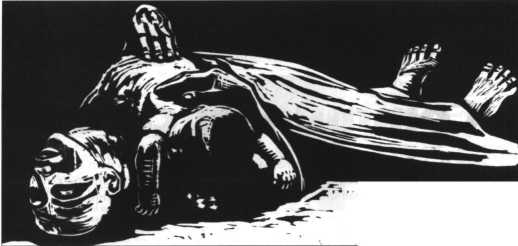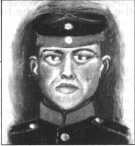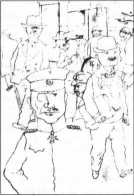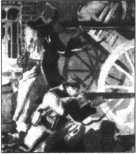
Over the top, John Nash
Chris Bambery Archive | ETOL Main Page
From Socialist Review, No. 179, October 1994.
Copyright © Socialist Review.
Copied from the Socialist Review Archive.
Marked up by Einde O’ Callaghan for the Encyclopaedia of Trotskyism On-Line (ETOL).
|
Sometimes images can express reality more strongly than words. Chris Bambery reviews a new art exhibition whose work depicts the terror of the First World War and the hope that grew out of it |
Looking back on the First World War in his novel, Tender Is The Night, F. Scott Fitzgerald wrote of the slaughter in the trenches:

|
|
Over the top, John Nash |
‘All my beautiful lovely safe world blew itself up here with a great gust of high explosive love’.
To understand what Fitzgerald meant, visit this exhibition at London’s Barbican Gallery and contrast two self portraits by the German artist, Otto Dix. Self portrait as a Soldier was painted in 1914 and showed his enthusiasm for the war in those early months. A year later his Self portrait as Shooting Target shows an entirely different man. Dix survived to produce a series of etchings in 1924 showing disturbing images of the Western Front as a counterblast to the militarism of the German right.
This exhibition looks at the reactions of avant garde artists to the war. If the term avant garde is to mean anything it describes a variety of artists who broke from the classic, romantic tradition of the 19th century. They were rebelling against a capitalist world and the impact of machinery and modern production techniques. The front line of this movement was in those cities which were being cast into the melting pot of mass industrialisation – Vienna, Milan, Barcelona and St Petersburg.

|
|
Torso in metal from the ‘Rock Drill’, Jacob Epstein |
When used to describe this generation of artists, the term avant garde includes expressionism, where the object’s dimensions are torn apart and its colours distorted to reveal its true nature. It also includes futurism – a movement largely based in Italy and Russia – where artists consciously wanted to celebrate the age of the machine.
The Italian futurist, Marinetti, welcomed the war, campaigning for Italy’s entry on the side of France and Britain, because it would be ‘the health giver of the world’. This idea was taken up by the British futurist, Christopher Nevinson, who stated in 1915:
‘This war will be a violent incentive to Futurism, for we believe that there is no beauty except in strike, and no masterpiece without aggressiveness’.

|
|
The widow II, Käthe Kollwitz |
The slaughter led Nevinson to break from abstract art to produce in 1916 La Patrie, a painting of dead and wounded lying in a Dunkirk shed waiting evacuation. A year later the British government censored Nevinson’s Paths of Glory, because it depicted British dead. Nevinson’s War Profiteers gives a political edge to his anger.
In 1913 Jacob Epstein exhibited a metal sculpture of the torso of a man working with a drill. In 1916 he returned to lop off its limbs to produce a shocking portrayal of terrible, frightening wounds.

|
|
Self portrait as shooting target, |

|
|
Berlin street scene, George Grosz |

|
|
The soldiers of King Albert the Ready, Walter Sickert |
There is in this exhibition a sense of premonition in the final years before the war of what lay ahead. Bohumil Kubista, serving with the army of the Austro-Hungarian Empire in the Balkan Wars of 1912 and 1913, painted Heavy Artillery in Action, which could have been any of the battles three or four years later – the Somme, Verdun or Passchendaele. The German artist, Franz Marc, died at Verdun, but in 1913 he painted The Unfortunate Land of Tyrol, which seems to herald a future cataclysm.
The title of this exhibition, A Bitter Truth, gives a good sense of experiences and reactions to the war of the various artists on exhibition here. There are some exceptions. Walter Sickert, by 1914 an establishment figure, has two paintings on show celebrating ‘brave little Belgium’, whose defence was the reason presented for Britain’s war with Germany. The American artist George Bellows returned to this theme shortly after his country’s entry into the war with Massacre at Dinant, depicting the massacres supposedly inflicted on Belgian civilians by the conquering German army.
The British artist Paul Nash’s sense of despair is on display in his ironically titled We are Making a New World, showing the day breaking over the shattered landscape of the trenches. Nash’s The Mule Track, far from being a celebration of the machine, shows all the horrors of modern technology in the shape of high velocity shells and shrapnel being unleashed on humanity.
There is a common sense of horror at the realities of the war. But beyond that it is difficult to say more. In the world that emerged after 1918 much of the avant garde was moving into the mainstream – as can be seen with the English artist, Stanley Spencer. Even in his 1916 depiction of a dressing station in Macedonia there is no cry of anger. It is almost as if in death or suffering there is redemption. By 1922 his Unveiling Cookham War Memorial seems to be a celebration of the timeless Englishness of this Thames Valley village.
Whatever the similarities between the different artists showing here, they were moving in different directions – artistically and politically. For, as the war ended in revolution, the two could not be separated.
The Russian artist Malevich made six lithographs in 1914 appealing in a naive, cartoon like style to support the Tsar’s war effort. By the war’s end Malevich supported the Bolshevik Revolution. The Italian futurist, Marinetti, became a champion of Mussolini’s fascism – a political path followed by the British artist Wyndham Lewis.
This exhibition offers something more than ‘war is hell’. The experience of war was a threshold to a more fragmented and unconfident world. This is a world with which we are familiar and that’s why anyone who has a couple of hours to spare should make an effort to see this exhibition.
The final word must go to the works of those artists working in Germany between the wars end and the victory of Nazism. The sculptures and woodcuts of Kathe Kollwitz, George Grosz’s drawing Berlin Street Scene and Dix’s etchings are works of artists who have gone beyond examining the bitter truth of the war to portray the naked reality of the society which spawned such horrors.
A Bitter Truth – Avant Garde Art and the Great War: Barbican Art Gallery, London, 29 September–1 December, Admission £41.50 (£12.50 concessions, reduced admission £12.50 every evening Monday–Friday 5 p.m.)
Chris Bambery Archive | ETOL Main Page
Last updated: 1 May 2017